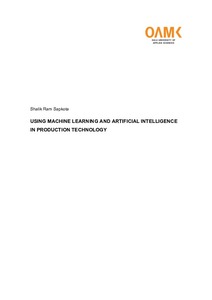Using Machine Learning and Artificial Intelligence in Production Technology
Sapkota, Shalik Ram (2019)
Sapkota, Shalik Ram
2019
All rights reserved. This publication is copyrighted. You may download, display and print it for Your own personal use. Commercial use is prohibited.
Julkaisun pysyvä osoite on
https://urn.fi/URN:NBN:fi:amk-2019052812782
https://urn.fi/URN:NBN:fi:amk-2019052812782
Tiivistelmä
This thesis is the product of collaboration of Centria R&D and Akkuser Oy, with the purpose of developing battery sorting system with machine vision and AI. As the industrial world is entering towards the fourth industrial revolution, AI, machine learning and deep learning are hot topics. In neural networks, a convolutional neural network is widely used to do image recognition, image classification and object detection. The aim of this thesis study was to find out the best solution to classify different kinds of used batteries according to their images to find out their inside chemical composition using the latest technology available now.
To find out the best solution to classify object, we used Google’s Tensorflow and OpenCV were used as tools inside the Anaconda virtual environment. In technical words, deep learning CNN models were implemented during training and testing. Series of convolutional layers with filters, a max pooling layer, fully connected layers and other functional requirements were applied to detect whether object is classified or not. The result of this thesis work was good as expected even with limited resources. For implementing this project in real life, many other functions such as databases, a user interface and human-usable application need to be developed.
To find out the best solution to classify object, we used Google’s Tensorflow and OpenCV were used as tools inside the Anaconda virtual environment. In technical words, deep learning CNN models were implemented during training and testing. Series of convolutional layers with filters, a max pooling layer, fully connected layers and other functional requirements were applied to detect whether object is classified or not. The result of this thesis work was good as expected even with limited resources. For implementing this project in real life, many other functions such as databases, a user interface and human-usable application need to be developed.
